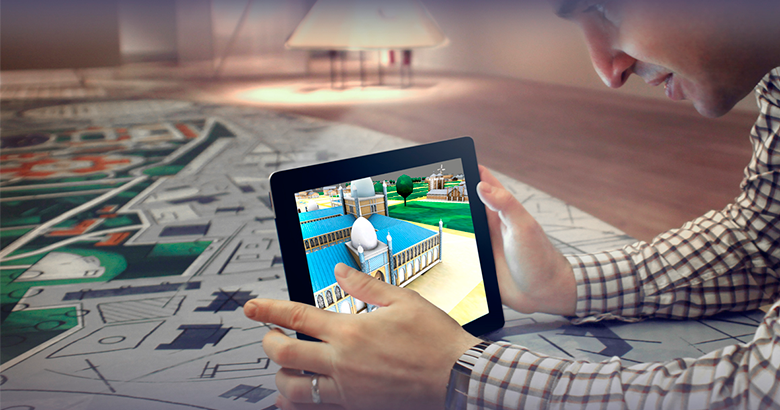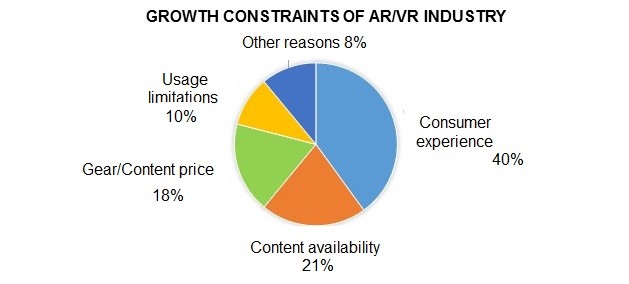In the article of Delo.Ua, Chernovetskyi Investment Group Associate – Yevgen Netreba – had told in which spheres VR/AR technologies are already used today and where they are going to be used in nearest few years.
Read the text below or on the primary source:
https://delo.ua/business/chto-tehnologija-dopolnen...

To see each of the seven wonders of the world, to see a new apartment, when the developer has not even laid the foundation yet, to plunge into the game or to feel like you are the main character. All of this, and much more, today is provided by the virtual and augmented reality technology. According to Goldman Sachs, by 2017 the total price of projects using VR/AR was $3.5 billion.
AR/VR has a wide range of capacity. The integration of AR/VR elements into everyday life takes place through various channels. According to the reports provided by the range of analytical magazines, AR/VR applications will transform the majority of industrial branches within the next five-seven years. The most probable branches for integration is entertainment, e-commerce, public health, tourism and even publishing industry. First of all, we have to realize that AR/VR revolution is going either to transform a particular industry completely or just supplement certain fields of industrial marketplace.
The onset of VR/AR technology was in 1990s. Companies began to promote actively some products with the elements of Augmented Reality. The case example is the video game console Virtual Boy by Nintendo. Yet, due to the poor assortment of games, the new technology failed on the market. Nintendo faced the need to close the project. The next few years, AR/VR development was a kind of anabiosis. There were no significant changes in promoting AR/VR products.
The new wave of interest to AR/VR arose in 2012-2013 when Oculus VR collected $2.5 million on Kickstarter for Oculus Rift Glasses development. At the same time, Google announced “Google Glass”. Despite the fact that Google eventually packed in the project and Oculus VR presented Rift Glasses only in 2016 (Gear VR had been presented by Samsung together with Oculus a year earlier), for the rest of developers it was a sign that consumers were ready to appreciate the mixed reality.
In the wake of AR/VR popularity, retail companies joined the race. For them VR technology to be an additional channel of communication with a client.
IKEA has been experimenting with AR-soft through an application which allows the clients to visualize furniture from the catalogue in their apartments. Ukrainian retail company Allo uses a similar technique.
Ukraine
Ukraine is far from being an outsider in the field of AR/VR development. There are already dozens of projects.
Among the market players, we can distinguish AR/VR studios that create content (ByOwls, Lemon Group), companies creating software (Lookinar, Program-Ace), and companies creating their own product in one of the fields (VRNET, Fablab Fabricator, Sensorama, ARbrowser).
The biggest deal in this field over 2018 is a crowdfunding campaign by FeelVR start-up on the Kickstarter platform at the end of May. The team raised the necessary $60 thousand in the first hour of the campaign and eventually received $500 thousand. In general, investments in this field in Ukraine are carried out by business angels, and are private, therefore information about them is virtually absent. Thus, 2018 can be called more than successful for this industry in Ukraine. In addition to the FeelVR project, which has been already mentioned, other projects are picking up steam also, and have found their consumers.
VR projects in Ukraine were also promoted by consumer projects, for instance, an Aftermath VR documentary about Euromaidan events, that was released this year, an augmented reality book “Alice in Wonderland”, or a MIM VR quest developed by the already mentioned Lookinar studio.
Problems of growth
There is a problem with finding the growth drivers. Who will be the main driver of the market? Would it be soft makers with their mobile applications or gear manufacturers who provide an improvement in experiencing AR/VR?
Analytics agreed that gear manufacturers are the locomotive of promoting VR/AR now. Because they create gear for users. But the industry can’t gain success without high-quality software. Gear manufacturers stimulate program engineers to work on the software and build up the industry.
Apps are still being developed. It makes the engineers be careful with investment. Mostly, in development and scouting the appropriate platforms.
Some analysts claim that product prices will remain rather high because of their newness, but manufacturers are going to keep the gross profit down in order to increase sales. In the following years,acc the prices will go down, but gross profit will increase due to sales growth.
The forecast shows that a market of equipment is going to rise slower than a market of software in the next years, as consumers will be conservative and careful buying an AR/VR gear. The main reason will be its higher price in contrast to software. Yet the volume correlation of gear and soft manufacturers will be changing with the development. According to Goldman Sachs, the total volume of the market will reach $80 billion by 2025 ($45 billion for hardware-market and $35 billion for software). The last will perform better in the gaming field ($11.6 billion of profit), public health ($5.1 billion), engineering ($4.7 billion) and broadcasting ($4.1 billion).

The results of new pole run by international company Perkins Coie LLP have shown the globally growing tendency of branch’s growth, which is paying more attention to practical apps and facing, at the same time, with the problem of the clients’ base extension.
AR/VR technologies’ development supposes interaction between the consumer and developer. The customers’ readiness to absorb proposed technologies is an important factor for branch’s development as well. Restraining factors, according to the Perkins Coie’s poll, are:

Main technological companies, which want to enter the AR/VR market and prefer not to spend inner resources on the creation of the particular department, but to buy an existent startup that runs similar activity. The above-mentioned state is verified by the fact that in 2014 Facebook had bought Oculus, and Google had invested $542 million in Magic leap.

Transactions costs related to AR/VR often are not disclosed, because usually they are carried out by the companies, which want to hide the intention of entrance on the AR/VR market. However, the data exists that five hundred and three deals had been taking place during 2005-2015. The total sum of those deals is $2.8 billion:
• 396 deals on finance of application development ($2.1 billion;
• 107 deals on hardware development ($0.7 billion).

Investment companies’ interests for AR developers have changed as well. If in the beginning of branch’s development was traced the process of investment majorly in the companies, at the early stages of their development, that topped out in 2014 with the approximate income of $650 million (in general the process is limited because of the branch’s recent existence), whereas now such type of investment has decreased to $250 million, ceding to the investment into the companies, at the advanced stage of development (which counts approximately $850 million). Before strategic buyers usually invested money in the small company at its early stage of development with the intention to buy it later, in case the company’s development or income will overcome threshold level. At the moment the investors have changed their preferences, choosing the companies that have already had the product and profit (the ability to generate the cash flow).
The more breaking down AR/VR project, financed by technological giants, will be waiting on us in the future. However, consumers’ needs and its technological implementation have to be defined. The balance between software and hardware’s development can supply the branch with firm development that will bring us closer to the age of the mixed reality.
The terms AR (Augmented Reality) and VR (Virtual Reality) describe the integration of images, data, information and virtual graphics with the user’s natural environment in real time (for AR) or simulated environment (for VR). Both of these technologies are classified as “mixed reality”.